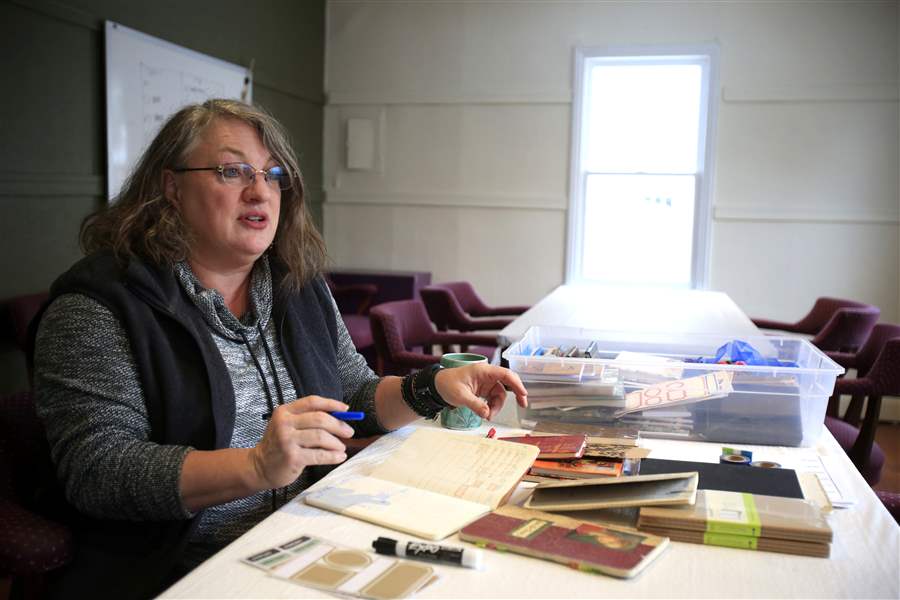
Bullet journals help people organize their chaotic lives
1/12/2018
Kelly Averill Savino speaks during an interview about bullet journals at Hands-On Studio at Toledo Botanical Garden in Toledo on Wednesday, January 3, 2018.
The Blade/Kurt Steiss
Buy This Image
Kelly Savino has always considered herself a journaler, even if she didn’t use the most organized method.
“By college, I would carry around three-ring binders, and it would have my class notes and my ‘here's what happened today’ and venting about things and scribbling doodles and drawing pictures and making grocery lists,” the 56-year-old Toledoan said. “It was always loose paper everywhere. I would have this notebook and that notebook, and I would have pockets stuffed with little notes — ‘important, next Thursday at 3 o’clock’ — but I would have no idea what that meant.
“I made lists, but they were everywhere. They were on the fridge. They would come up in the dryer.”
Ms. Savino is not a linear thinker. Her kitchen cupboards are covered with chalkboard paint to write random thoughts with the chalk at hand. In her bathroom, next to her toothbrush, is a dry-erase marker that is used on the mirror in the same manner. Siri helps remind her of appointments and important events.
But what really holds her life together at the seams is the bullet journal she carries at all times, replacing a purse or wallet into which most people drop notes.
“It’s a visual of your life you don’t get any other way,” Ms. Savino said. “Everything in my scattered brain has a page.”
A bullet journal is pretty much what it sounds like: a journal in which daily activities, weekly and monthly to-do lists, habit trackers, random thoughts, lists, logs, goals, and bucket lists are created on its pages in bullet/check-off form.
In its basic form, it includes an index page; a daily, weekly, monthly and/or yearly planner, and a habit tracker. Beyond to-do lists, event planning, and grocery lists, people keep track of spending, track fitbit steps, hone their bucket lists, plan meals, make note of books they want to read and movies they want to watch, doodle, or write inspirational quotes.
The concept was developed by Ryder Carroll, a Brooklyn-based digital product designer who at a young age created a way to manage his attention-deficit disorder.
“I designed it for myself; I never assumed it could help other people,” Mr. Carroll said during a 2017 TEDx talk. “I was focusing on way too many things at the same time. As an adult that's just known as being busy. But being busy doesn’t always mean you are being productive.”
On the advice of friends with whom he shared his process, Mr. Carroll launched bulletjournal.com in 2013, which includes a how-to video and other information about bullet journals. The concept soared.
On his website, Mr. Carroll describes bullet journals as a way to make mental inventories that allow people to live their “intentional life,” without distraction from tasks that aren’t vital. He advises bullet journalers to keep entries simple through “rapid logging” — utilizing topics, page numbers, short sentences, and bullets — to avoid giving up and abandoning the journal.
Ms. Savino teaches bullet journaling classes at Hands-On Studio at the Toledo Botanical Garden. Individuals who take her one-session workshops range from those with obsessive compulsive disorder who can’t wait to track their lives to those who are just trying to adapt to not being organized.
Journals can be elaborate. Or not so much. Googling bullet journals on social media brings up thousands of extremely beautiful, extremely detailed books with calligraphy writing and decorative artwork.
Tricia Cosgrove, 44, is a biotechnical engineer with Bowser-Morner Inc. and also co-owns Black Swamp Auction Services. She has been bullet journaling for about a year and a half and said it has changed her productivity.
“I’ve had planners, but always felt kind of constrained by calendar blocks,” she said. “I really like this because it’s flexible, and I can put what I need when and where I need it in here, and it’s really worked out well for me.”
Ms. Cosgrove said she has a separate health and wellness bullet journal where she tracks dieting, sleeping habits, meditation, and daily reflections
Although she said she is dabbling this year with a fancier version, her bullet journals are mostly about substance.
Ms. Savino has a master’s degree in folklore from the University of Oregon and a master’s of fine arts with a concentration on ceramics from Eastern Michigan. She, along with 20 other instructors, teaches a variety of classes and workshops at Hands-On, a studio she created and directs. She describes her bullet journals as visual tools, as well, and has advice for those who are initially overwhelmed by the concept.
“I tell people who are stressed out about it, if your book doesn’t look like an artist made it, you’re probably not an artist. You may be a list maker. You may be a scribbler — love your scribbles,” she said. “It doesn’t have to make any sense. And the thing people forget is, you’re not turning this in. You’re not ever going to be graded on it. No one ever has to see it.”
For more information on bullet journaling, go to bulletjournal.com. For more information local bullet journaling classes, go to the Hands-On journaling Facebook page or to artvillage419.org.
Contact Roberta Gedert at rgedert@theblade.com, 419-724-6075, or on Twitter @RoGedert.